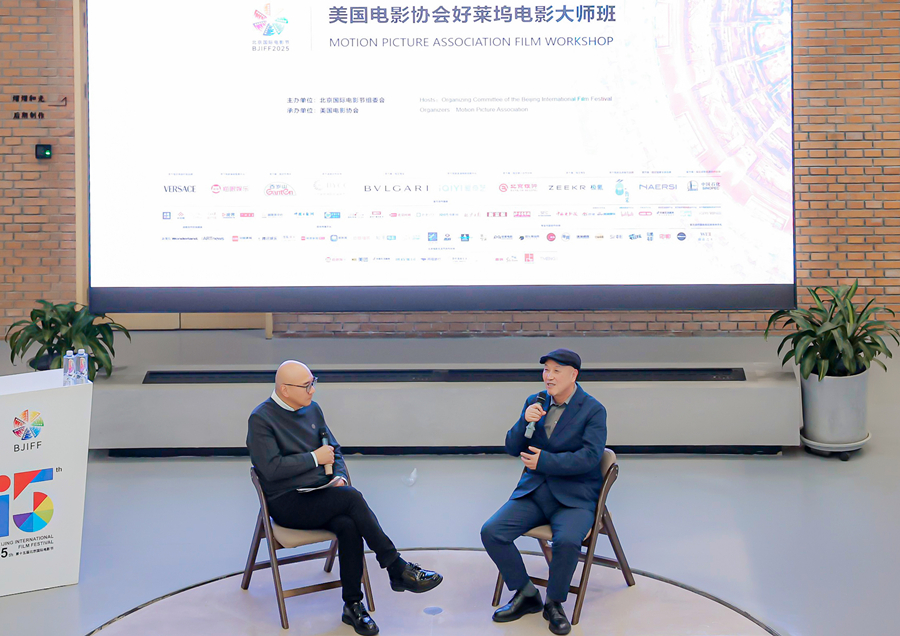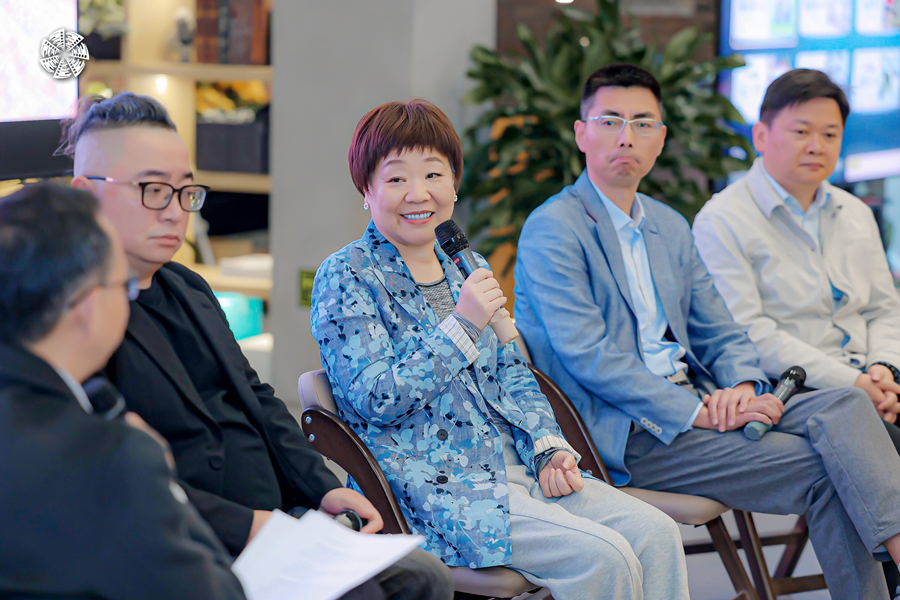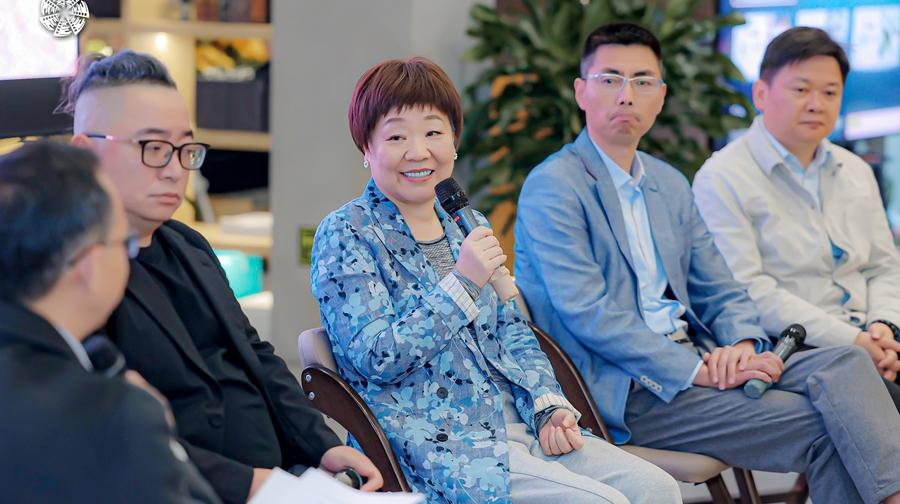Industry leaders gathered at the Motion Picture Association (MPA) Film Workshop, held on April 21 during the Beijing International Film Festival (BJIFF), to discuss Hollywood distribution trends and China's video-on-demand (VOD) platform business models.

William Feng, head of Greater China for the Motion Picture Association, speaks with Huo Tingxiao, president of the China Film Art Society, at the MPA Film Workshop in Beijing, April 21, 2025. [Photo courtesy of the BJIFF Organizing Committee]
William Feng, MPA head of Greater China and vice president for Asia Pacific, said VOD's global rise had created unprecedented challenges for traditional studios' distribution strategies and content investments. However, he noted that throughout cinema's century-long history, each technological disruption has presented both challenges and opportunities.
"VOD has significantly expanded market opportunities for films, particularly mid- and low-budget productions," Feng said. "For blockbusters, premium VOD platforms have become a crucial revenue stream beyond theatrical box office earnings, enabling studios to sustain high-quality production."
China's internet users topped 1.1 billion in 2024, according to the China Internet Network Information Center's latest statistical report on internet development. A separate March report on internet audiovisual services revealed that 1.09 billion people, 98.4% of the country's internet population, use online video platforms. The report showed that long-form video viewership hit 752 million users, its highest level since 2018.
For comparison, Feng cited industry data showing that 89% of U.S. households subscribe to streaming services, including premium video-on-demand platforms, maintaining an average of four subscriptions per household, with monthly spending reaching $69. U.S. consumer spending across digital and physical home entertainment formats hit $43 billion in 2023, far exceeding theatrical releases, which remained below $10 billion during the same period.
He emphasized that harnessing VOD's potential to upgrade China's film industry and transform it into a new growth engine requires collective innovation across the sector to achieve high-quality development.
Zhang Wengang, executive director of the UHD World Association, noted that U.S. tariffs have had the surprising effect of stimulating innovation in China's ultra-high-definition (UHD) sector despite their negative impact on the broader film industry
"The UHD sector remains highly active, with continuous technological innovations driving industry development," Zhang said. "Tariffs have impacted both Hollywood and domestic Chinese films, yet led to greater genre diversification that will create a more competitive and vibrant market landscape moving forward."
Zhang also emphasized that the UHD World Association, as the first international technology-focused organization registered in China, has gathered numerous members from leading enterprises across the industrial chain while making continuous breakthroughs in UHD technical standards.
The workshop included a discussion with Huo Tingxiao, vice chairman of the China Film Association and president of the China Film Art Society, who examined how emerging technologies are transforming artistic production in filmmaking. Huo told attendees that digital technology applications have created significant new opportunities for film artists.
A panel discussion on "Exploring New Paths to Maximize Value of High-Quality Film Content" followed. Li Ning, senior vice president of New Classics Media Group and CEO of New Classics Pictures under Yuewen, said paid online viewing habits aren't fully established in China. He emphasized that UHD development must balance theater revenues with platform profits, noting issues like anti-piracy and data-based revenue sharing need further industry solutions.

Gillian Zhao, senior vice president of iQiyi, speaks at a panel discussion during the MPA Film Workshop in Beijing, April 21, 2025. [Photo courtesy of BJIFF Organizing Committee]
Blockbuster producers prefer longer theatrical runs to maximize returns, while underperforming films increasingly depend on digital platforms for revenue, said Gillian Zhao, senior vice president at Chinese streaming giant iQiyi. Theaters must emphasize their unique advantages in visual effects and the event-like experience of cinema-going to compete with the convenience of home viewing, Zhao told attendees.
For video-on-demand releases to succeed, they need three key elements, according to Li Hui, dedicated network head of the Larger-Screen Operation Center at Migu Culture Technology. He said VOD platforms must offer high-quality content, superior viewing experiences with home theater-level picture quality and features for multiple viewers, and technology that works smoothly across different devices.
Tang Wenxue, department director of the HD Business Division at E-surfing Digital Life Technology, explained how telecom companies are launching ultra-high-definition TV services using fast internet connections to deliver crystal-clear picture and sound quality to homes.
He noted these services need strong copyright protection. With China Telecom already reaching 150 million users, Tang said UHD home viewing has significant growth potential. He suggested offering bundled packages and broadband upgrades to encourage customers to pay for premium content.
The BJIFF and the MPA have jointly organized annual film workshops since 2014, bringing Hollywood executives and experts to share expertise with Chinese filmmakers. The workshops have become an essential platform for China-U.S. film industry exchanges, helping Chinese directors gain international exposure and collaborative opportunities.







 京公網安備 11010802027341號
京公網安備 11010802027341號 主站蜘蛛池模板:
国产视频一区在线观看|
日本在线理论片|
亚洲高清无在码在线电影不卡|
色屁屁www欧美激情在线观看
|
日本人内谢69xxxx|
亚洲aⅴ男人的天堂在线观看|
91av电影在线观看|
岛国免费v片在线播放|
亚洲乱码一二三四区乱码|
污污视频在线观看免费|
免费在线黄网站|
美国bbbbbbbbb免费毛片|
国产三级a三级三级|
香蕉免费一区二区三区|
国产欧美日本亚洲精品一4区|
717午夜伦伦电影理论片|
成人区视频爽爽爽爽爽|
久久久国产99久久国产久|
日韩精品无码一区二区三区|
亚洲人成无码网站久久99热国产|
欧美精品在线一区二区三区|
人人揉人人捏人人添|
相泽亚洲一区中文字幕|
冻千秋的堕落h污文冬妃|
美女双腿打开让男人桶爽网站|
国产三级无码内射在线看|
麻豆91免费视频|
国产成人无码a区在线观看视频|
亚洲精品福利你懂|
国产精品人人做人人爽人人添
|
丰满人妻一区二区三区视频53|
日本漂亮继坶中文字幕|
久久精品国产99久久丝袜|
日韩精品无码一区二区三区|
九九热视频精品|
最近中文国语字幕在线播放视频|
亚洲av无码精品国产成人|
欧美xxxxx性喷潮|
亚洲一区二区日韩欧美gif|
欧美一级在线观看|
亚洲av永久无码精品网站|
主站蜘蛛池模板:
国产视频一区在线观看|
日本在线理论片|
亚洲高清无在码在线电影不卡|
色屁屁www欧美激情在线观看
|
日本人内谢69xxxx|
亚洲aⅴ男人的天堂在线观看|
91av电影在线观看|
岛国免费v片在线播放|
亚洲乱码一二三四区乱码|
污污视频在线观看免费|
免费在线黄网站|
美国bbbbbbbbb免费毛片|
国产三级a三级三级|
香蕉免费一区二区三区|
国产欧美日本亚洲精品一4区|
717午夜伦伦电影理论片|
成人区视频爽爽爽爽爽|
久久久国产99久久国产久|
日韩精品无码一区二区三区|
亚洲人成无码网站久久99热国产|
欧美精品在线一区二区三区|
人人揉人人捏人人添|
相泽亚洲一区中文字幕|
冻千秋的堕落h污文冬妃|
美女双腿打开让男人桶爽网站|
国产三级无码内射在线看|
麻豆91免费视频|
国产成人无码a区在线观看视频|
亚洲精品福利你懂|
国产精品人人做人人爽人人添
|
丰满人妻一区二区三区视频53|
日本漂亮继坶中文字幕|
久久精品国产99久久丝袜|
日韩精品无码一区二区三区|
九九热视频精品|
最近中文国语字幕在线播放视频|
亚洲av无码精品国产成人|
欧美xxxxx性喷潮|
亚洲一区二区日韩欧美gif|
欧美一级在线观看|
亚洲av永久无码精品网站|